Leverkusen’s positional play approach – midfield-box concept
In the last games of the season, Leverkusen used an interesting approach in their positional play, creating a 3-2-2-3 (midfield-box) staggering from the initial 4-2-3-1 shape, which basically changed the whole dynamics of their positional play.
From 4-2-3-1 to a 3-2-2-3
In order to keep the original rules of spacing & staggering (Juego de Posicion) and to create an optimal dynamics in between the lines -offer depth in both halfspaces-, a switch from the 4-2-3-1 was necessary. There are definitely a lot of different ways to change the structure -move into 2-3-2-3, 2-3-3-2, 3-1-3-3 etc.-, but based on Bosz’s initial approach both at Ajax & Dortmund -both in a 4-1-4-1/2-3-2-3- it was inevitable that he is going to imply a system according to the JdP principles -max 2 players in the same vertical channel-, whilst still being flexible. The last point is particularly present at Bosz’s philosophy, as his system allows more movements inside the structure as opposed to Guardiola’s system, which is much more rigid in that regard.
Midfield-box
Also, when creating a specific shape it’s important to consider the possible manipulative effects it has on the defensive structure. For instance, pushing up a full-back might result the oppositional winger’s opponent/man-oriented defensive behavior, which creates a different dynamics -also requires different patterns, movements to penetrate/exploit- opposed to a more shifting-oriented defensive system, where a high full-back would usually be closed down by a full-back, again resulting in a different wide dynamics.
In this sense creating the midfield-box at the centre -2-2 staggering inside- also have a different effect, especially on the oppositional 2nd line: from this perspective it can be interesting to differentiate between the specific strategies of how and where! to manipulate the oppositional structure with a higher emphasis -e.g. overloading the centre will most likely manipulate the defending of the 2nd line, whilst overloading the last line will again create a different effect, now on the last line’s movements. Although in order to create an optimal dynamics some rules must be applied. The central-midfielders have to position themselves in front of the oppositional 2nd line, whilst the attacking-midfielders are positioned higher, behind the 2nd line, in between the lines. Also, the central-midfielders should be positioned more to the centre -adapting to the opponent: inner side/shoulder of the oppositional central-midfielder-, whilst the attacking-midfielders have to be wider generally -outer side/shoulder of the oppositional central-midfielder, occupying the space between the CM-W channel. These rules help the central players to avoid blocking each other, offering more passing options, whilst maintaining the central channel towards the central-forward open. Knowing the Bosz system, more flexibility is allowed, but only within these principles. As said before, occupying the central areas with 4 players manipulates the 2nd line, since it divides the attention of the central-midfielders -causing decisional-crisis with doubling them-, therefore it will naturally result more penetrative actions from the 3 central zones -also important to consider strategically.
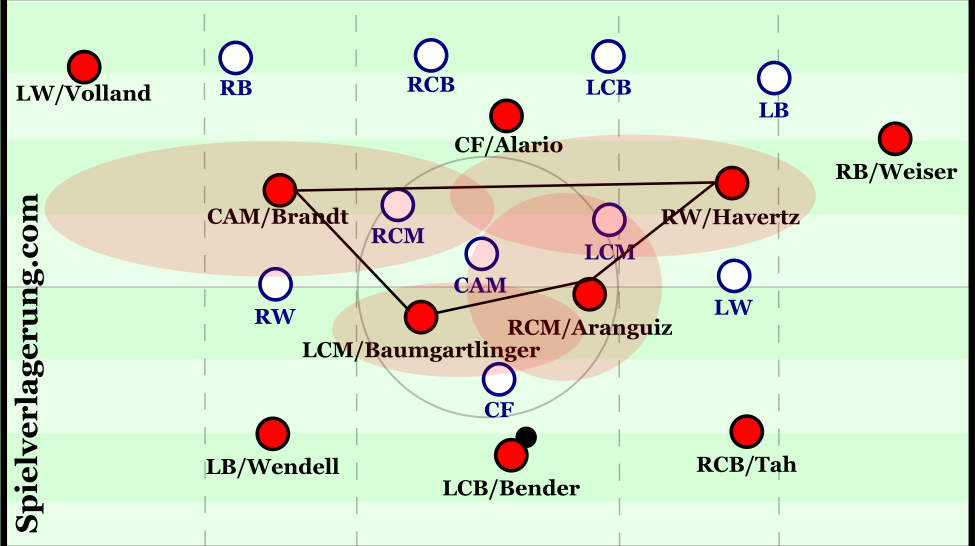
With having 3 at the back, the circulation dynamics changes as well. The ability to constantly move the ball is essential to have an effective JdP, but the focus of this might vary. To keep the original comparison, whilst Guardiola’s Manchester City in the 4-1-4-1/2-3-2-3 -keeping the back 4- focuses to circulate the ball more horizontally in the, then use verticality (horizontal to move/stretch the opponent -› prepare/create the verticality) to penetrate, the 3-2-2-3 focuses more on verticality, since the back 3’s can’t stretch/move the oppositional shape that much horizontally, as it’s important to maintain optimal distances -to avoid being too wide to disrupt connections-, but enough to invite the press/pull out players from the oppositional 2nd line, to open up the verticality. With a slight change though, it’s possible to create hybrid-ish system, with the midfielders dropping deep & back 3 to move out wide, forming a 1-4-2-3 structure.

Depending on the defensive system different dynamics occur in terms of progressing the ball into advanced areas. For instance, against a 4-4-2 block there is a higher probability to exploit the outside-to-inside dynamics, whilst against a 5-4-1 block the inside-to-outside pattern will be more frequent.
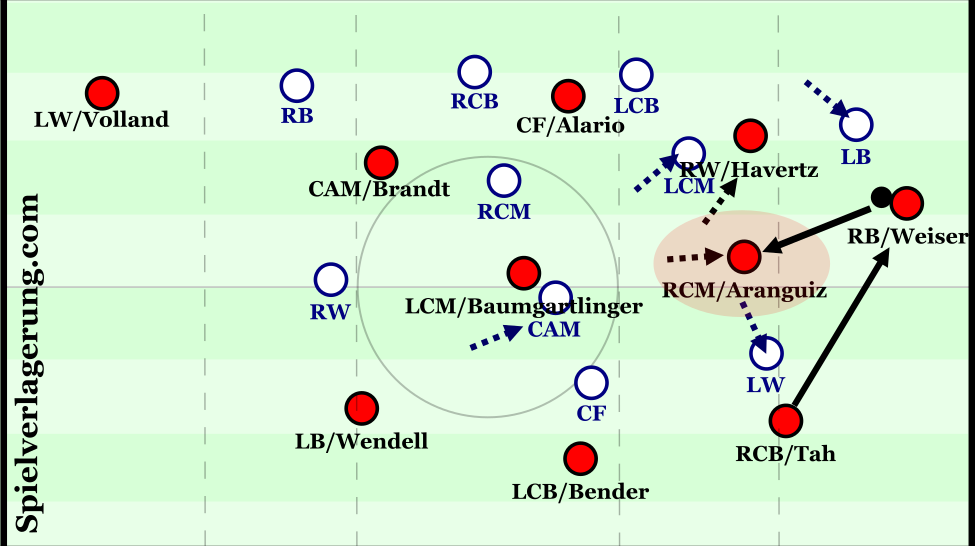
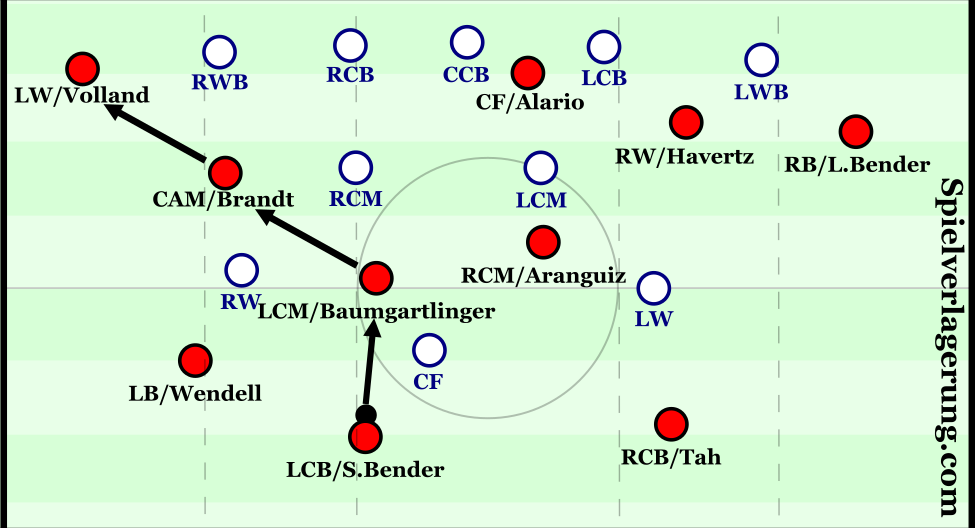
Referring to the earlier mentioned manipulative effects, in this system it’s key to avoid opponent-oriented defensive behaviors, in order to create a more optimal positional situation for the inside winger/Havertz in between the lines. Since if he is being followed closely by the full-back, he won’t have the space/opportunity to turn directly from the pass into an open space, to exploit his ability to accelerate on the ball & use diagonality. Although as the system allows more flexibility, Brandt-Havertz are free to move horizontally to the centre as a principle, to solve the issue of being marked tightly from the back. To assure the open spaces it’s important to maintain the aforementioned principles of staggering, therefore Havertz usually positions himself closer to the 2nd line -between the lines- to manipulate their defensive behavior, plus the right-back pushes higher up -higher than Havertz- to pin the oppositional full-back & create the space for Havertz. Here it’s also important to mention the role of player profiles: in order to successfully implement the midfield-box -in the same way Leverkusen does- we need:
- full-back -› comfortable at advanced positions, ability to make runs behind the last line & crossing, extra: 1v1 ability to dribble past the opponent ~ Weiser
- winger/attacking midfielder -› dynamism on the ball & turn into spaces in behind using the 1st touch, high press retention, accurate lay-offs, make diagonal runs behind the last line, dribbling diagonally inside, flexibility to operate deeper ~ Brandt & Havertz
- central-midfielder -› can play deeper in front of the centre-backs to control the circulation/tempo, press retention to handle pressure from behind (blind-side alertness), flexibility to operate 1 line higher & making runs in depth ~ Aranguiz
Principles
Due to being more fluent the system allows the midfield-box to make specific movement, breaking the 2-2 staggering to offer more dynamism -as opposed to the more rigid zonal attack principle-, often changing into a 1-3 or 3-1 staggering, or simply creating an asymmetric version of the 2-2. Although the basic principle is to always occupy the ballnear halfspace (priority, if not possibly – occupy the centre) in depth, therefore even though the attacking midfielders are moving outwards -as Brandt often did against Schalke’s 5-3-2 to stretch the 2nd line- a central-midfielder will push higher up to occupy that zone -creating a 1-3 staggering. Same happens when Brandt and Havertz are dribbling inside diagonally from deeper positions -in front of the oppositional 2nd line. As the depth must be assured a central-midfielder will push higher up in the halfspace or the centre to offer an option in between the lines, a dynamic rotation of the midfield-box. Using the concept of diagonality a specific rule/principle can also be stated: “use ballfar central-midfielder for ballnear diagonality, use ballnear central-midfielder for ballfar diagonality.”
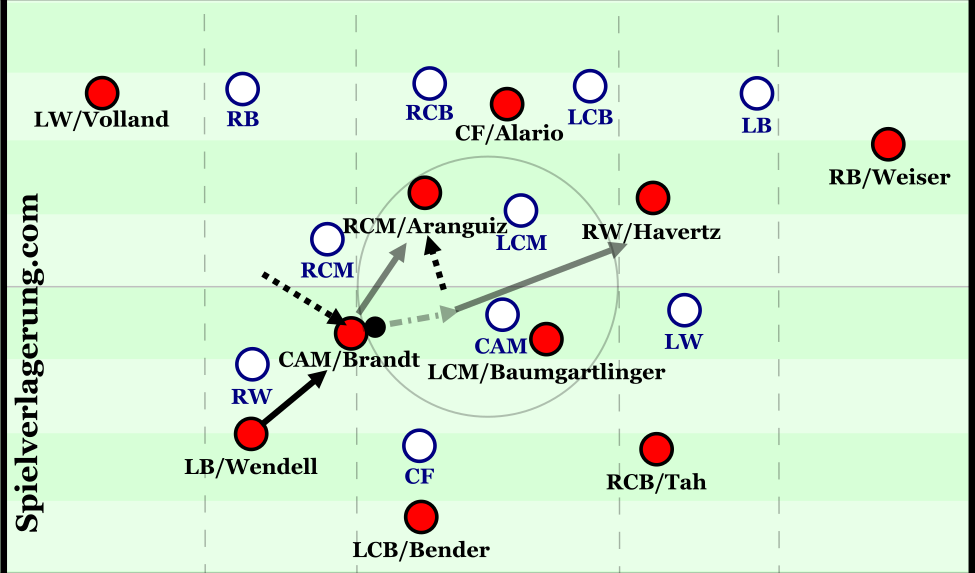
Positional switches might happen to create asymmetry, which has the effect of pinning the oppositional last line, opening up spaces in between the lines. I call it ‘vertical overload’, with the occupation of the same channel the further player’s role effectively is to block a defender to open up a passing lane, create space in depth, plus to assure accessibility towards the deeper player. This concept or principle is quite effective against 5-defender systems. These flexible movements could also serve to separate from the tighter marking or to simply confuse the 1st & 2nd line’s defensive behavior, reducing the cover and opening more space & time for the on-ball actions.
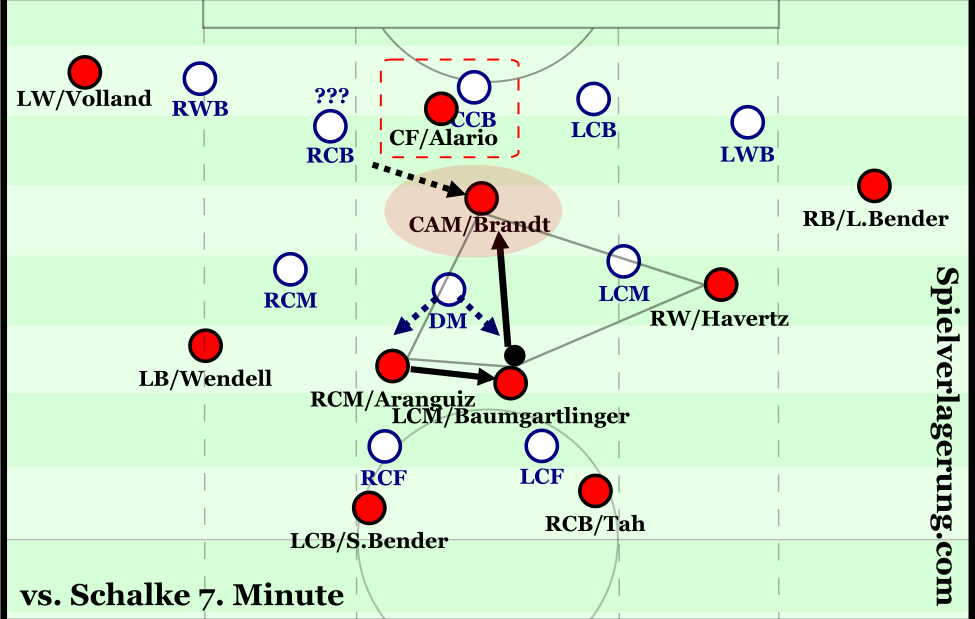
Another principle is to create an overload after penetration, so Brandt and Havertz often find themselves on the same side to accomplish that, especially at the attacking third. Beyond the several advantages -e.g. combination play/one-twos, lay-offs etc.- it has a specific effect to stretch the oppositional last line with pulling out the ballnear centre-back wider at the penetration’s zone, to open up more spaces inside, underloading the box.

Manipulative effects
At first, the 2-2 staggering usually creates orientation issues for the 1st line. For example, against a 4-4-1-1 it’s generally easier to open up the access towards the central-midfielders: if the oppositional forward presses high, it creates a 2v1 in behind. To avoid that, the 1st line can drop deeper into a 4-4-2-0 shape, to close both central-midfielders, but that would make the circulation easier for the back 3 -reducing the cover. From there using the wide zones the access can be created towards the midfielders, with the outside-to-inside pattern.
The midfield-box can also tighten the 2nd line due to the basic numbers at the ballnear zones, which could open the access to the ballfar zones, using the principle of ‘gathering the opponent to one side, to finish on the other’. This effect could be extremely valuable against 5-defender systems, where ballfar separation from the last line can be created for the attacking-midfielders, to open spaces to dribble forward into. It can also happen when the attacking midfielder moves outwards -switching from 2-2 to a 1-3 staggering, movement principles-, which stretches the 2nd line as it moves/forces the oppositional central-midfielder wider, resulting a disconnection between the central-midfielders at the centre, plus more spaces open on the far-side -decreasing the access, as now more time/space required for optimal shifting.
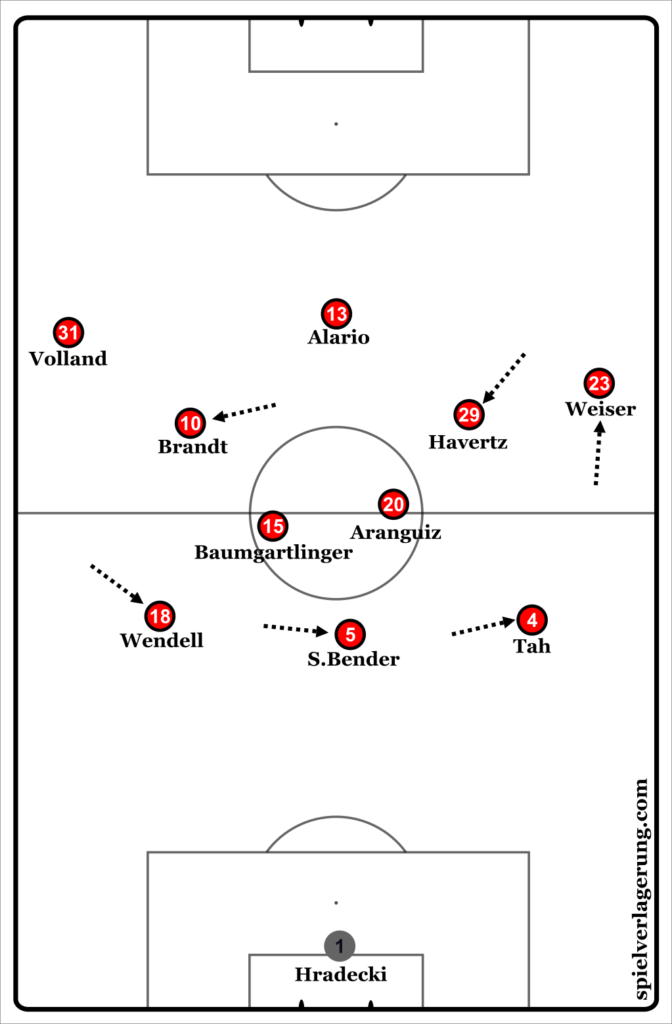
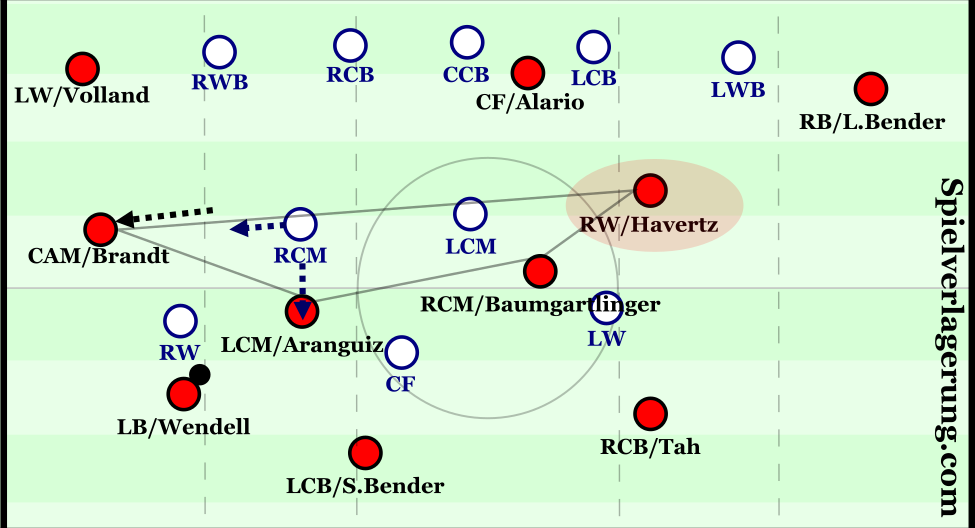
Keine Kommentare vorhanden Alle anzeigen